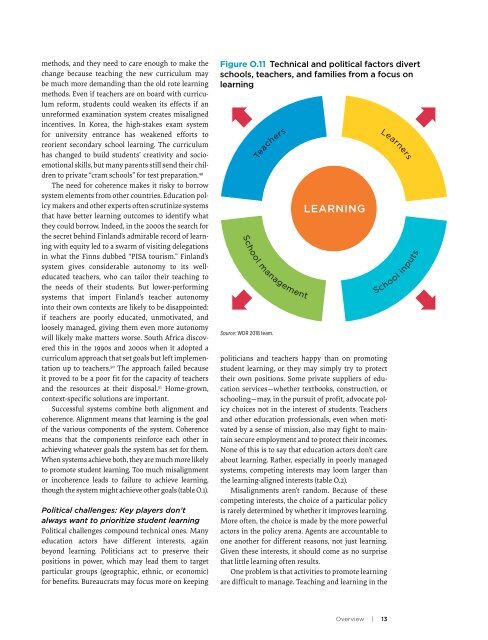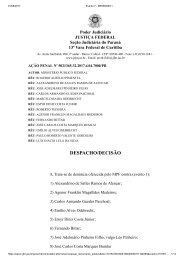Brasil só deve dominar Leitura em 260 anos, aponta estudo do Banco Mundial Relatorio Banco Mundial _Learning
Create successful ePaper yourself
Turn your PDF publications into a flip-book with our unique Google optimized e-Paper software.
methods, and they need to care enough to make the<br />
change because teaching the new curriculum may<br />
be much more d<strong>em</strong>anding than the old rote learning<br />
methods. Even if teachers are on board with curriculum<br />
reform, students could weaken its effects if an<br />
unreformed examination syst<strong>em</strong> creates misaligned<br />
incentives. In Korea, the high-stakes exam syst<strong>em</strong><br />
for university entrance has weakened efforts to<br />
reorient secondary school learning. The curriculum<br />
has changed to build students’ creativity and socio<strong>em</strong>otional<br />
skills, but many parents still send their children<br />
to private “cram schools” for test preparation. 49<br />
The need for coherence makes it risky to borrow<br />
syst<strong>em</strong> el<strong>em</strong>ents from other countries. Education policy<br />
makers and other experts often scrutinize syst<strong>em</strong>s<br />
that have better learning outcomes to identify what<br />
they could borrow. Indeed, in the 2000s the search for<br />
the secret behind Finland’s admirable record of learning<br />
with equity led to a swarm of visiting delegations<br />
in what the Finns dubbed “PISA tourism.” Finland’s<br />
syst<strong>em</strong> gives considerable autonomy to its welleducated<br />
teachers, who can tailor their teaching to<br />
the needs of their students. But lower-performing<br />
syst<strong>em</strong>s that import Finland’s teacher autonomy<br />
into their own contexts are likely to be disappointed:<br />
if teachers are poorly educated, unmotivated, and<br />
loosely managed, giving th<strong>em</strong> even more autonomy<br />
will likely make matters worse. South Africa discovered<br />
this in the 1990s and 2000s when it a<strong>do</strong>pted a<br />
curriculum approach that set goals but left impl<strong>em</strong>entation<br />
up to teachers. 50 The approach failed because<br />
it proved to be a poor fit for the capacity of teachers<br />
and the resources at their disposal. 51 Home-grown,<br />
context-specific solutions are important.<br />
Successful syst<strong>em</strong>s combine both alignment and<br />
coherence. Alignment means that learning is the goal<br />
of the various components of the syst<strong>em</strong>. Coherence<br />
means that the components reinforce each other in<br />
achieving whatever goals the syst<strong>em</strong> has set for th<strong>em</strong>.<br />
When syst<strong>em</strong>s achieve both, they are much more likely<br />
to promote student learning. Too much misalignment<br />
or incoherence leads to failure to achieve learning,<br />
though the syst<strong>em</strong> might achieve other goals (table O.1).<br />
Political challenges: Key players <strong>do</strong>n’t<br />
always want to prioritize student learning<br />
Political challenges compound technical ones. Many<br />
education actors have different interests, again<br />
beyond learning. Politicians act to preserve their<br />
positions in power, which may lead th<strong>em</strong> to target<br />
particular groups (geographic, ethnic, or economic)<br />
for benefits. Bureaucrats may focus more on keeping<br />
Figure O.11 Technical and political factors divert<br />
schools, teachers, and families from a focus on<br />
learning<br />
Teachers<br />
School manag<strong>em</strong>ent<br />
Source: WDR 2018 team.<br />
LEARNING<br />
politicians and teachers happy than on promoting<br />
student learning, or they may simply try to protect<br />
their own positions. Some private suppliers of education<br />
services—whether textbooks, construction, or<br />
schooling—may, in the pursuit of profit, advocate policy<br />
choices not in the interest of students. Teachers<br />
and other education professionals, even when motivated<br />
by a sense of mission, also may fight to maintain<br />
secure <strong>em</strong>ployment and to protect their incomes.<br />
None of this is to say that education actors <strong>do</strong>n’t care<br />
about learning. Rather, especially in poorly managed<br />
syst<strong>em</strong>s, competing interests may loom larger than<br />
the learning-aligned interests (table O.2).<br />
Misalignments aren’t ran<strong>do</strong>m. Because of these<br />
competing interests, the choice of a particular policy<br />
is rarely determined by whether it improves learning.<br />
More often, the choice is made by the more powerful<br />
actors in the policy arena. Agents are accountable to<br />
one another for different reasons, not just learning.<br />
Given these interests, it should come as no surprise<br />
that little learning often results.<br />
One probl<strong>em</strong> is that activities to promote learning<br />
are difficult to manage. Teaching and learning in the<br />
Learners<br />
School inputs<br />
Overview | 13








